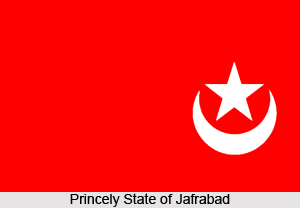 Princely state of Jafrabad was one of the well known 11 gun salute states of India that were administered by native rulers or Indian princes under the indirect control of the British Government of India. It was situated in Gujarat at about 240 kilometres southwest of Vadodara and 275 kilometres south of Ahmedabad. It was a part of Kathiawar Agency under the suzerainty of the Bombay Presidency. The territory was under the jurisdiction of Nawab of Janjira on the Konkan coast. On a personal front, Jafarabad and Janjira were united. Princely state of Jafrabad spanned over an area of 68 square kilometres. It constituted a total population of 13,837 in the year 1941.The majority of population in the region comprised Muslims, around 80 percent, and the rest were Hindus. A city along with 8 villages constitutes the princely state of Jafrabad. The place derived its name from Sultan Muzaffar Jafar from Gujarat who constructed the fortifications.
Princely state of Jafrabad was one of the well known 11 gun salute states of India that were administered by native rulers or Indian princes under the indirect control of the British Government of India. It was situated in Gujarat at about 240 kilometres southwest of Vadodara and 275 kilometres south of Ahmedabad. It was a part of Kathiawar Agency under the suzerainty of the Bombay Presidency. The territory was under the jurisdiction of Nawab of Janjira on the Konkan coast. On a personal front, Jafarabad and Janjira were united. Princely state of Jafrabad spanned over an area of 68 square kilometres. It constituted a total population of 13,837 in the year 1941.The majority of population in the region comprised Muslims, around 80 percent, and the rest were Hindus. A city along with 8 villages constitutes the princely state of Jafrabad. The place derived its name from Sultan Muzaffar Jafar from Gujarat who constructed the fortifications.
Princely state of Jafrabad constituted 2 coastal districts which were located on both sides of the Ranai estuary. The native state was a remote block of territory enclaved in Junagadh, Babariawad and the island of Shial. Princely state of Jafrabad initially contained only the town of Jafrabad and the hinterland, but later the territory of the state was enlarged by the inclusion of neighbouring areas that came under the protection of the erstwhile native state. Princely state of Jafrabad was previously incorporated as a part of the Baroda Agency, which was a sub division of Western India States Agency. Later the region became a part of the Indian state of Gujarat.
History of princely state of Jafrabad says that in about 1731, the rule of Mughal Emperors relaxed in Gujarat which rendered independence to the local thanadar, an ally in the Muslim Mughal garrison. Devoted to piracy, the local thanedar and the local Kolis began attacking the ships and commercial traffic from Surat repeatedly. The prince of Janjira dynasty, named Sidi Hilal, who was in Surat then counterattacked the Kolis and captured them by destroying their boats. He also demanded a high fine from them. This became unaffordable to the thanedar of Jafrabad and thus he sold the region to Sidi Hilal in the year 1759. However owing to the scenario of lawlessness in Kathiawar peninsula, the city could not be protected by the Siddis and was transferred to the British. The debt was paid by the Nawab of Janjira who was then appointed the governor for the region.
Princely state of Jafrabad was accorded as a salute state of India with a gun salute of 11 guns. The province of Jafrabad was ranked 12th in order of precedence among the states of Western India, between Wankaner and Gondal. A representative or Mamlatdar with judicial and revenue authority resided at Jafrabad on behalf of the former princely state of Janjira. The state of Jafrabad received tribute from Junagadh. The native ruler of the state held the title of Nawab. He exercised civil and criminal jurisdictional powers and also managed and administered the internal affairs of the state. The Nawab of Jafrabad, who was also the Nawab of Janjira, the personal union of the 2 states was established in the year 1762. The flag of princely state of Jafrabad was the same as that of Janjira.
After the withdrawal of the British and the independence of India on 15th August 1947, the native ruler ascended his state to the newly formed Union of India, also known as the Dominion of India. At present, Jafrabad is a municipality and a city in the district of Amreli, in Gujarat.



















